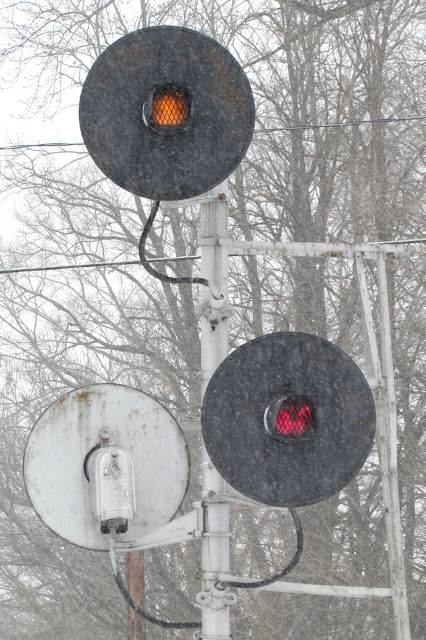The first solution was to use the color and shape of a semaphore blade to define the type of signal and the rules involved. Absolute signals were painted red with a squared off end while distant signals were given a fishtail end and painted yellow. When permissive automatics came on the scene the fishtail was inverted into a point with the yellow background and black band remaining.
Of course semaphore signals are only disable during conditions of daylight. For the nighttime a marker light was applied below the main head. Also popular on position light signals, marker lights were the common way to define an automatic in the position/semaphore systems. Although there were the occasional exception of using a marker to denote an absolute signal (I'm looking at you N&W), more often the markers were used to make absolute signals that could be switched to act like a permissive signal.
Alright, you have your marker, but what if you also have absolute signals with more than one head. It's possible to mistake the marker for a lower absolute head in the darkness, even if the marker was smaller. One solution would be to use a yellow or lunar marker, but back in the day railroads still wanted a distinction between Stop and Proceed and a rolling Restricting. The solution was to offset the signal heads, using the relative position to convey the permissive meaning.
At this point someone realized that maybe they should just tell the crews that a signal was permissive. In the United States a number of railroads, typically in the South, adopted the (P) board for "Permissive".
Canadian railroads, on the other hand, have gone with a [R] Board for Restricting.
Of course the easiest/cheapest solution was to simply use the milepost number plate, useful in defining the particular the signal location, to also indicate a permissive status. Now milepost number plates have been around since the dawn of the automatic signal era with Hall Banjo, so why the need for markers and offset heads? Well reflector technology was pretty primitive up until the 1960's, either consisting of white paint with a bit of glass or glass cats eye jewels. Film plastic reflectors was what gave the railroads assurance that the number plate would be distinguishable at sufficient distance at night (at least when they still cared about such things).
Of course one outlier from the whole number plate system is Canada where offset heads or [R] boards are used instead. In fact, virtually all signals, absolute and permissive, come with a number plate denoting either the milepost or signal (lever) designation.







No comments:
Post a Comment